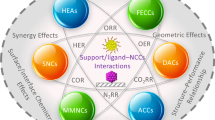Abstract
Nitrogen-containing carbon nanotubes, or N-CNTs, are a class of materials with interesting catalytic properties and with less toxic properties than bare carbon nanotubes. Herein, the relative stability, the oxidation potential, conductivity, and structural characteristics of finite, open H-terminated single-walled N-CNTs and their saturated structures are investigated by density functional theory methods at the B3LYP/6-31G(d) level of theory. The principal aim is to understand the way different structural features can determine or modify N-CNTs properties and reactivity. Frequency calculations indicate that all of the final optimized nanostructures correspond to a minimum on the potential energy surface. The formation energies, band gaps, atomic charges, and reactivity descriptors such as chemical potential, hardness, electrophilicity index, and softness are compared. The results indicate that changes in hybridization, chirality, and diameter strongly modify the properties of N-CNTs. The nitrogen content and the length of the nanotubes also contribute to changes in their properties, albeit to a lesser degree. For instance, a (8,0) zigzag N-CNT with 4 nitrogen atoms exhibits a band gap of 0 eV. Moreover, the configuration or relative positions of the nitrogen atoms in the central part of the nanotube do not significantly affect the nanotube properties. Compared with zigzag and chiral nanotubes, armchair N-CNTs exhibit a favorable electrical charge distribution and are revealed as potentially good catalysts for oxygen reduction reactions.





Similar content being viewed by others
References
Yoosefian M, Barzgari Z, Yoosefian J (2014) Struct Chem 25(1):9
Abdelhalim A, Abdellah A, Scarpa G, Lugli P (2014) Nanotechnol 25(5):5208. doi:10.1088/0957-4484/25/5/055208
De Volder MFL, Tawfick SH, Baughman RH, Hart AJ (2013) Science 339:535
Bareket-Keren L, Hanein Y (2013) Front Neural Circuits 6:112. doi:10.3389/fncir.2012.00122
Bianco S (2011) Carbon Nanotubes. From Research to Applications, Intech, Croatia
Marulanda JM (2010) Carbon Nanotubes. In-The, India
Chełmecka E, Pasterny K, Kupka T, Stobin L (2011) Phys Status Solidi A 208(8):1774. doi:10.1002/pssa.201001113
Li H, Kim I (2011) In: Bianco S (ed) Carbon Nanotubes. From Research to Applications, chap 13. Intech, p 211
Liu Z, Tabakman S, Welsher K, Dai H (2009) Nano Res 2:85. doi:10.1007/s12274-009-9009-8
Contreras ML, Avila D, Alvarez J, Rozas R (2010) Struct Chem 21(3):573
Liu R, Wu D, Feng X, Mullen K (2010) Angew Chem Int Ed 49:2565
Hu X, Zhou Z, Lin Q, Wu Y, Zhang Z (2011) Chem Phys Lett 503:287
Gong KP, Du ZH, Xia ZH, Durstock M, Dai LM (2009) Science 323(5915):760
Terrones M (2007) Acta Microscopica 16(2):33
Hamadanian M, Khoshnevisan B, Fotooh FK (2011) Struct Chem 22:1205. doi:10.1007/s11224-011-9814-z
Bilic A, Gale JD (2008) J Phys Chem C 112:12568
Dinadayalane TC, Kaczmarek A, Lukaszewicz J, Leszczynski J (2007) J Phys Chem C 111:7376
Contreras ML, Cortés-Arriagada D, Villarroel I, Alvarez J, Rozas R (2014) Struct Chem 25:1045. doi:10.1007/s11224-013-0377-z
Karachi N, Boshra A, Jadidi S (2011) Struct Chem 22:805. doi:10.1007/s11224-011-9761-8
Baei MT, Peyghan AA, Moghimi M (2012) Monatsh Chem. doi:10.1007/s00706-012-0739-z
Contreras ML, Avila D, Alvarez J, Rozas R (2012) J Mol Graphs Mod 38:389
HyperChem release 7.5 Hypercube Inc 1115 NW 4th Street Gainesville Florida 32601 USA
Jaguar version 7.5 Schrödinger LLC New York NY 2008
Parr RG, Yang W (1989) Density functional theory of atoms and molecules. Oxford University Press, New York
Pearson RG (1997) Chemical hardness. Wiley, Oxford
Parr RG, Pearson RG (1983) J Am Chem Soc 105:7512
Parr RG, von Szentpaly L, Liu S (1999) J Am Chem Soc 121:1922
Koopmans TA (1933) Physica 1:104
Roy KK, Saha S (2010) Annu Rep Prog Chem. Sect C 106:118
Geerlings P, De Proft F, Langenaeker W (2003) Chem Rev 103:1793
Pearson RG (1987) J Phys Chem Educ 64:561
Toro-Labbé A (1999) J Phys Chem A 103:4398
Gómez-Jeria JS (2013) Canadian Chem Trans 1:25
Dinadayalane TC, Leszczynski J (2010) Struct Chem 21:1155
Zhao M, Xia Y, Lewis JP, Zhang RJ (2003) Appl Phys 94:2398
Ho YW, Suen MC (2013) J Chem 2013:765243. doi:10.1155/2013/765243
Jin JC, Sun ZH, Yang MY, Wu J, Liu XH (2013) J Chem 2013:521757. doi:10.1155/2013/521757
Mulliken RS (1955) J Chem Phys 23:1833
Xiong W, Du F, Liu Y, Perez A Jr, Supp M, Ramakrishnan TS, Dai L, Jiang L (2010) J Am Chem Soc 132:15839
Jaque P, Toro-Labbé A (2000) J Phys Chem A 104:995
Chattaraj PK, Fuentealba P, Gómez B, Contreras R (2000) J Am Chem Soc 122:348
Solà M, Toro-Labbé A (1999) J Phys Chem A 103:8847
Sicilia E, Russo N, Mineva T (2001) J Phys Chem A 105:442
Torrent-Sucarrat M, Luis JM, Duran M, Solà M (2001) J Am Chem Soc 123:7951
Saha S, Dinadayalane TC, Leszczynska D, Leszczynski J (2012) Chem Phys Lett 541:85
Saha S, Dinadayalane TC, Murray JS, Leszczynska D, Leszczynski J (2012) J Phys Chem C 116:22399
Saha S, Dinadayalane TC, Leszczynska D, Leszczynski J (2013) Chem Phys Lett 565:69
Acknowledgments
This work was partially supported by the Direction of Scientific and Technological Research DICYT-USACH Project Nr. 061342CF and by the Sociedad de Desarrollo Tecnológico SDT-USACH project Nr. CIA 2981. In addition, the central cluster of the Faculty of Chemistry and Biology and the VRIDeI of the University of Santiago de Chile are acknowledged for allocating computational resources.
Conflict of interest
The authors declare that they have no conflict of interest.
Author information
Authors and Affiliations
Corresponding author
Rights and permissions
About this article
Cite this article
Contreras, M.L., Villarroel, I. & Rozas, R. How structural parameters affect the reactivity of saturated and non-saturated nitrogen-doped single-walled carbon nanotubes of different chiralities: a density functional theory approach. Struct Chem 26, 761–771 (2015). https://doi.org/10.1007/s11224-014-0535-y
Received:
Accepted:
Published:
Issue Date:
DOI: https://doi.org/10.1007/s11224-014-0535-y




